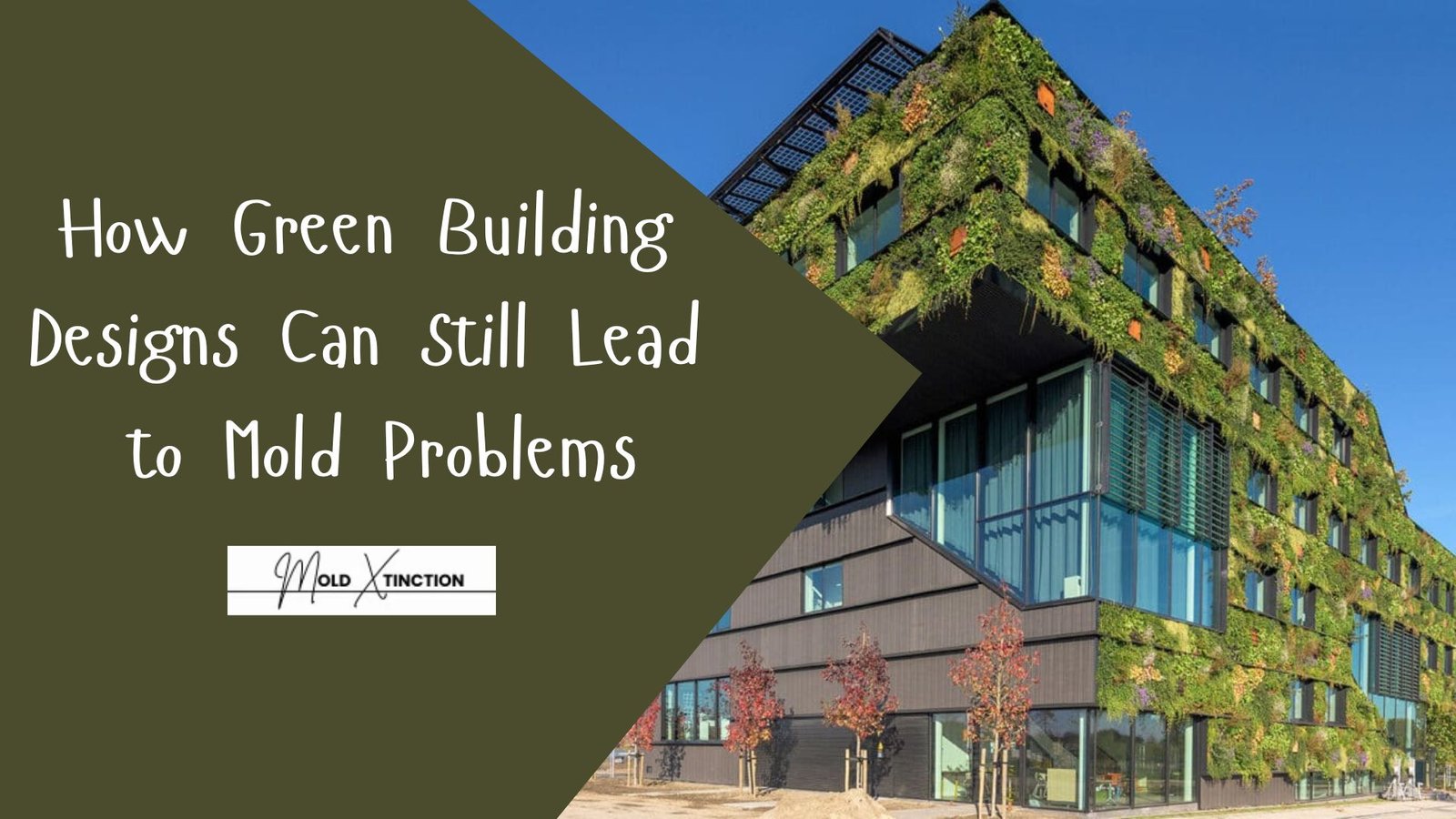Today, I will show you exactly how green building designs can still lead to mold problems. I understand that you want to minimize waste, save money, and develop a healthy environment, but then it’s still a trap for mold.
Green building designs are awesome to save energy and the environment, and this is a fact that can’t be erased.
More and more people these days want environmentally friendly housing and construction that will not harm the earth.
Such buildings are built without using much water, electricity, and even waste materials as compared to our normal buildings.
They come with smart components that include solar panels, rain catchment, and power-Node economical machines.
These green buildings are healthier and friendlier to the environment.
To be honest, even with all the mentioned benefits, green buildings may also have a mold issue to address. Mold is not concerned whether your building is new and tidy or not; all it requires is moisture.
It is possible to grow a mould, yes, even in the most modern, clean and green buildings where moisture is confined to the inside.
So why does this happen? Are there signs to look out for? What can you do when mould appears in your green home?
What's In This Article
ToggleWhat Is a Green Building?
A green building is a house or any office that is built and developed with extra care to save the environment.
It’s all about using the resources efficiently and making them last longer, like saving energy and water, and producing less garbage.
These are buildings that will reduce pollution and its effects on nature. This is because one is aiming to give people a healthy environment to work or live in and keep the Earth safe in the future.
These buildings often include:
- Power-saving windows and doors
- Proper insulation
- Rainwater systems
- Sustainable materials
- An efficient cooling and heating system
The houses assist in reducing waste, reducing power bills and healthy living.
But this is where the problem is…
Green Building Designs Can Trap Moisture
Green buildings are airtight to save energy. This means they trap hot air in cold days and cold air in hot days inside the house.
Sealing the building saves on heating and cooling of the building. However, in the case when the building is hermetically closed, then there is no escape of the water.
You may assume that moisture is attributed to the most frequent activities: cooking, taking a shower, washing clothes, or even to the breaking of two drops of the leaking faucet, and rain entering your house.
When this moisture is kept inside the building and gives no opportunity to dry, then it forms a wet environment inside the building.
This moisture may result in the growth of molds in concealed places, which may include within the walls, under floors, or even on your furniture, among others, which can be both unhealthy to you and the building.
How Green Building Designs Can Still Lead to Mold Problems

Let’s break it down into simple causes:
1. Poor Ventilation
Many green buildings are designed to be airtight to save energy. However, they are airtight, which does not permit free movement of air.
In case the dry air is not able to escape, it has nowhere to go, and the humidity rises. Over time, the state of trapped moisture can produce an environment ideal for growing mold in such spaces as:
- Bathrooms
- Kitchens
- Laundry rooms
When steam is inside, it’s the mold’s happy place.
2. Tight Insulation
Insulation helps contain the heat during cold days and release the heat during hot days and saves money and electricity. However, when the roof or the wall has a minor leakage, the water gets access to the insulation.
Long-term wetting makes insulation a mold’s paradise. Invisible mold can destroy the building and cause health issues to those who occupy the building.
3. Green Roofs and Rainwater Systems
Green roofs are cool and good for the environment by capturing rainwater and making buildings cool.
But if these roofs and rainwater systems are not installed well, water can seep into the building.
Once water is inside, you get wet surfaces and that’s where mold can start to grow fast – in some cases, mold can grow in as little as 24-48 hours.
This fast growth can cause damage and health problems unless corrected immediately.
4. Low Air Exchange
In normal households, air comes in and out automatically through open windows and crevices.
But in green buildings, special machines are used to regulate air flow to save energy. If these machines fail, air can get stale, and humidity can rise.
At high humidity, it’s mold’s happy place, and that can cause damage to the building and health issues to those who occupy the building.
5. Using Certain Eco Materials
Certain green building materials lessen the carbon impact and are friendly to the environment.
So note that, a majority of these materials are moisture-prone. When they get wet, they become a mold’s playground.
For example:* Recycled paper insulation
- Strawboard panels
- Wood-based tiles
They get moldy if wet for too long.
Mold in a Green Building
You live in a brand new, green, and eco-friendly house, but you should always check the walls of your home for signs of hacking.
Mold can still happen, and so constant checking will keep your house safe and healthy.
Here are the signs:
- Musty or damp smell
- Black, green, or white spots on walls orthe ceiling
- Peeling paint
- Allergies or breathing problems that get worse indoors
- High humidity
If you see or smell mold, don’t ignore it. Mold is not only ugly — it can hurt your health.
Why Mold is Bad Even in Eco Homes
We occupy green buildings to be healthy and save the Earth. But when there’s mold, it can:
- Stimulates sneezing, coughing, and irritation of the eyes
- Causes an asthma attack
- Damaging to children, older people, and people with a damaged immune system
- Damage walls, furniture, and floors
Mold in a green-house defeats the green building concept. That’s why it should be taken seriously.
How to Prevent Mold in Green Buildings
Here are a few smart steps to stop mold from showing up:
1. Install Good Ventilation Systems
The moist air should be able to come out through the unique vents of the bathroom, kitchen, and laundry rooms.
Put exhaust fans, especially when one has used the showers, has been cooking, and has washed clothes.
Open windows and let fresh air in, and drive out the moist air wherever possible. Moisture is reduced, and mold chances are lower with good air flow.
2. Keep the Humidity low
As soon as you experience the rainy or humid season, ensure that the moisture content in the air is minimized by putting a dehumidifier to use.
You are advised to keep the humidity within your house at low levels (below 50%) because mold thrives in this environment.
By using a simple hygrometer, you can know when it is the right time to apply dehumidifiers or even use fans so that the air may become dry and healthy.
3. Regular Maintenance
Make sure to check your roof, pipes and heating or cooling system frequently.
Seal any cracks or other leaks immediately identified. Address water issues in time so that water cannot seep into walls, floor or ceiling.
Regular inspection of house plumbing and water will prevent any unnoticed problems in water issues that will lead to the development of mold in places that are not clearly visible.
4. Use materials that Are Mold Resistant
When building, or even when doing any form of renovations, attempt to use insoluble materials instead of materials that absorb water.
The paints, walls, and floors are designed so as not to give a chance to grow of molds by organisms due to being dry and impermeable to water.
These are supplementary to protect areas which likely to get wet, such as the basement, bathroom, or the kitchen.
5. Observing Your Water Systems
A large number of green houses are designed with rain or grey water collection or storage, and reuse.
It is always important to ensure that these water systems are well-maintained, and you also get time to examine them when there are no issues, like any leaks or blockages.
Leak or overflow, even a little, may cause water seeping on the walls or the floors to turn into a mold paradise.
When the appropriate care is taken of these systems, then your house will be mold-free and dry.
When to Call a Mold Remediation Professional
Mold may still appear even if you do your best to keep a green building mold-free.
When you see mold growing, especially on a large area of the house or when it comes back even after you have cleaned it, don’t try to do it yourself, as mold can be hazardous.
Mold can be deceptive and sometimes hidden within the walls or behind the floors where you can’t see it.
This is very important to call a mold repairing company immediately. It’s their job to have the tools and experience to:
- Find hidden mold you might miss
- Remove mold safely without spreading spores around your home
- Prevent mold from coming back by fixing moisture problems properly
Trying to fix the mold situation yourself without knowledge and using the right tools and materials may only make it worse.
Mold spores can travel in the air and harm you more. In this case, always leave it to the trained professionals to do it safely and efficiently.
Conclusion
Everybody wants to have a green-house that’s economical and environmentally friendly. But as observed, this doesn’t rule out the possibility of having mold issues with green buildings, even more so than the older ones.
This is not because green designs are bad. This is because they must be managed well. A lot of bad airflow, materials sucking up moisture, and unnecessary sealing may turn our green house into a moldy one unless we take care of it.
Look at any leak. Check your humidity. Keep fresh air.
And when you suspect mold, the best thing to do is to call a reputable mold remediation company. They will clean your home safely and contribute to your health preservation.
Helpful Guide: How to Prevent Mold in Poorly Designed Houses


